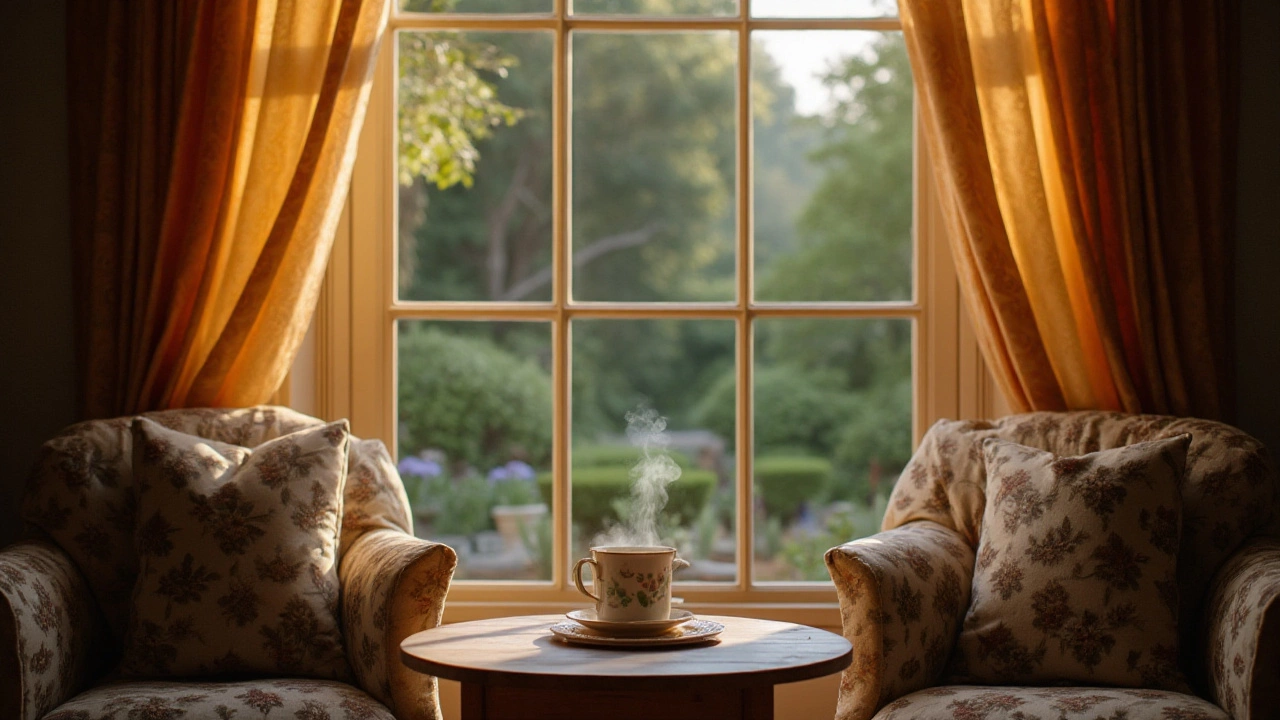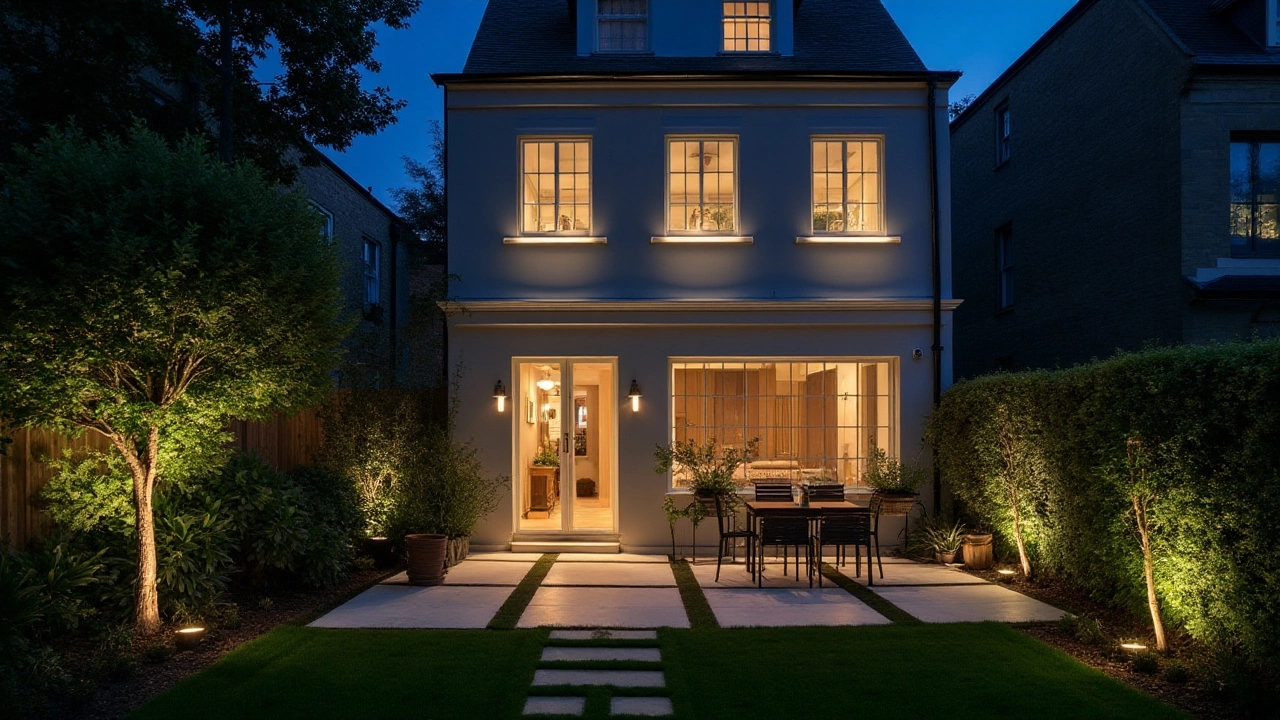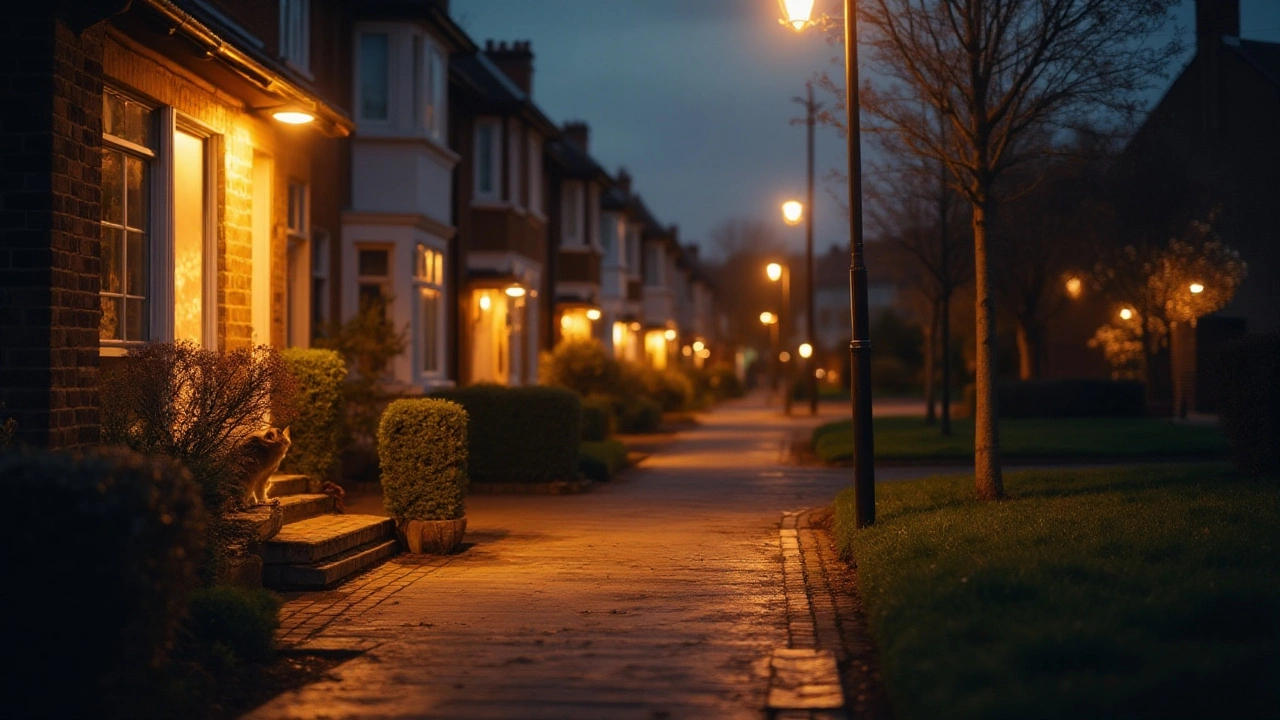When it comes to home security, one question often lingers in the minds of homeowners: do burglars really avoid houses with lights on? The notion isn't just an old wives' tale; it stems from the basic perception that a lit home is an occupied home, and thus, a riskier target for any would-be intruder.
Understanding how effective lighting can be depends not only on the technology you use but also on understanding criminal behavior and integrating lighting with other security measures. It's not as simple as flipping a switch; strategic placement and use of various lighting types can make all the difference in the world.
Delving into this topic will uncover practical ways to harness light as a powerful ally in your fight against home intrusions while knowing the limitations it presents. It's about making your home a place that doesn't just look safe but feels safe too.
- The Psychology of Burglars
- Effectiveness of Lights as Deterrence
- Comparing Lights to Other Security Measures
- Practical Lighting Tips for Home Security
- Combining Lights with Other Deterrents
The Psychology of Burglars
To truly deter burglars, it's essential to grasp the mindset of those who view your home as a potential target. The decision-making process of a burglar is quite methodical, often weighing risks against potential rewards. Understanding their psychology can be a powerful tool in preventing crime, and one unassuming factor that plays a significant role is lighting. A well-lit home isn't just about visibility; it's about the perception of occupancy, which is what many would-be intruders aim to avoid at all costs.
Criminal behavior experts highlight that burglars are primarily motivated by easy access and minimal chances of getting caught. They often perform a quick risk assessment, evaluating whether the benefits of stealing outweigh the risks of getting detected. Studies show that about 80% of burglars skip a house if an alarm system is visible, highlighting the psychological impact of even perceived deterrents. Similarly, a brightly lit house sends a clear signal: someone is likely home, reducing its allure as a target. As a famous security analyst once noted,
"A glowing porch light acts as a sentinel, standing guard over all who pass by."This kind of deterrent is both psychological and physical.
Yet, it's not just about the lights being on—it's about how they are used. Burglars are increasingly aware of simple tricks like a lamp on a timer that turns on at the same time every night. These predictable patterns can sometimes do more harm than good. Instead, experts suggest varying the light schedules or using smart home systems to randomize lights, making it difficult for burglars to discern whether someone's actually home. One man’s deterrent, or bright home security, may be another's beacon to proceed with caution.
Understanding the burglar's mindset doesn't stop at lights. Lifestyle choices, such as leaving cars in the driveway, determining which doors are easiest to access, and how visible valuables are from windows, all play a part. A survey of convicted burglars revealed that 60% would be deterred if confronted by a visible security system or the presence of cars at home. They shy away from homes that require too much effort to break into or involve too many unknowns. A key takeaway from these insights is that, while a house light sends a message, it should be part of a broader security strategy.
The influence of perceived risk on a burglar's decision goes beyond lights. The presence of dogs, fake security cameras, or even a wire fence and garden can work as effective deterrents. As we peel back layers of burglar psychology, it becomes evident that they thrive on predictability and routine. Breaking this routine, alongside visible measures like employing a strong burglar deterrent, forces them to rethink. This psychological play on their instincts is crucial for any comprehensive home security plan. Thus, while lights are powerful, they are most effective when combined intelligently with other preventive strategies.
Effectiveness of Lights as Deterrence
In the realm of home security, the use of house lights as a deterrent comes down to both psychological and tactical factors. It is a known fact that most burglars prefer to operate under the cover of darkness, minimizing their risk of being spotted. The mere presence of light can disrupt this notion, casting doubt on the success of an intrusion. Various studies support this logic, suggesting that a well-lit home reduces the opportunity for criminals to approach unnoticed. Hence, adopting a strategic lighting plan may significantly lower your home's vulnerability to break-ins.
While lights are integral, not all lighting is created equal. The strategic use of exterior lighting, such as motion-activated floodlights, can be particularly effective. These lights not only serve as a surprise factor that might scare off intruders but also provide clear visibility around key entry points, such as doors and windows. Positioning is essential; lights should illuminate vulnerable areas without creating deep shadows, which can be exploited as hiding spots. Consider layering your lighting—including porch, pathway, and landscape lights—to create a comprehensive defense barrier.
There's wisdom in realizing that lighting alone might not suffice. A savvy homeowner understands the importance of pairing lights with other home security measures. Contrary to popular belief, households with bright interiors at times inadvertently showcase themselves as easy marks if illumination patterns reveal signs of someone away, especially during extended periods. Smart lights, which can be programmed to mimic normal living patterns, add an extra layer of deception, creating the illusion of occupancy.
Citing a statement from the International Association of Chiefs of Police, they affirm, "Proper lighting is affordable, effective, and essential to premises security—albeit best used in coordination with other measures such as alarms and surveillance." A compelling insight that aligns with their observation is the nuanced impact of lighting on community-level crime deterrence; neighborhoods boasting good communal lighting often record lower crime rates compared to poorly lit counterparts. Communities that invest in improved street lights have demonstrated collective dips in criminal activities, proving the communal dimensions of lighting's deterrent power.
For those inclined towards technological solutions, innovations in lighting systems offer an array of options. From solar-powered fixtures to smartphone-controlled LEDs, the advancing world of smart home technology caters to rising demands for efficiency and effectiveness in security lighting. Take note, a balanced approach is key, combining the right amount of lighting with complementary crime prevention strategies that suit your specific home and its surroundings.

Comparing Lights to Other Security Measures
When bolstering home security, many homeowners instinctively turn to the power of illumination. But how do house lights stack up against a wide array of other security tools? Well, the effectiveness of lights as a deterrent hinges on several factors that extend beyond just brightness and coverage. One must consider the burglar’s perception of risk, the home's overall security system, and whether the lights indicate human presence or simply a static defense mechanism. That said, lights certainly play a crucial role in a broader security strategy, but they may not always deliver the standalone deterrence many hope for.
Alarm systems, like burglar alarms, are often perceived as more reliable safeguards against break-ins. These devices not only alert homeowners and neighbors to unauthorized entries but also often summon authorities to the scene. Modern systems offer various integrations, featuring motion detection, cameras, and smart home connectivity. While this makes them seemingly more comprehensive, they are not without their shortcomings. After all, false alarms are a common and occasionally costly downside. In contrast, a home brightly lit may avoid even triggering an attempt altogether, reducing reliance on reactive measures.
Another prevalent form of deterrence are security cameras. These lend an advantage lights alone cannot provide: a recordable and potentially identifiable visual of any intruder. High-resolution imagery, motion alerts sent directly to one’s phone, and the unmistakable eye on the street corner often keep suspicious activity at bay. However, they might not always deter the most brazen thieves, who may just don a mask to bypass this measure. Combining the constant eye of the lens with strategic lighting can highlight suspicious movements during crucial nighttime hours.
In the words of security expert and former burglary detective Jason Myers, “A multi-layered security approach that includes lights and active deterrence measures is always your best bet. Lighting alone can cause hesitation, but it’s when combined with other tools that it truly shines.”
Statistically, homes with comprehensive security systems are less likely to be targeted, as confirmed by numerous studies on burglary deterrence. The intuitive nature of lights as a straightforward deterrent cannot be overlooked. Yet, integrating them with other preventive measures truly creates a formidable shield against would-be intruders. The key lies in finding the right balance—just enough light to make entry conspicuous without over-relying on what burglars might see as simple stage lighting to an unguarded play.
The distinction doesn't end here. With a full arsenal ranging from smart locks that eliminate the old trick of picking locks to window sensors that alert on forced entries, a harmonized security strategy emerges as the frontrunner in keeping homes secure. Motion-activated lighting emerges as a fantastic complementary tool, adding a layer of surprise to catch intruders off-guard as they approach, fleeing from the spotlight quite literally.
In essence, there’s no one-size-fits-all answer to home security. It's about amalgamating lights with other measures to create a cohesive defense system. Whether utilizing light as an overture to stale darkness or as part of an orchestra of alarms, locks, and cameras, ensuring that your home remains a safe sanctuary at all times is the ultimate goal.
Practical Lighting Tips for Home Security
When enhancing your home security, leveraging home security lighting is a strategic move that demands careful planning and execution. The key is to create the illusion of an occupied home while maximizing visibility both inside and outside your premises. One effective approach is to install motion-sensor lights in key areas such as entrances, driveways, and backyards. Motion-sensor lights have the unique advantage of surprising and temporarily blinding potential intruders, making them reconsider their actions. Moreover, they save electricity compared to lights that stay on all night, making them not only a security measure but also an environmentally-friendly choice.
Smart Lighting for Smarter Security
Technology advancements have ushered in the era of smart lighting, allowing homeowners to take control of their security like never before. With smart bulbs connected to home networks, you can program lights to follow a schedule or adjust from a distance using your smartphone. This offers the flexibility to make your home look occupied even if you're on a trip miles away. Systems like these can even be synched with virtual home assistants, adding an extra layer of ease and integration within your home's security ecosystem.According to Elizabeth Smith from the Home Security Council, "Smart lighting systems have revolutionized the way we think about home security. They give homeowners peace of mind and the ability to monitor their lighting efficiently and effectively."
It's also crucial to consider layering your house lights across different zones to eliminate dark spots where intruders may hide. Each entry point, from windows to backdoors, should be covered. Consider using LED lights for their longevity and energy efficiency, ensuring your areas remain well-lit without the fear of bulb burnout. It's not only about the brightness; it's about strategic positioning that enhances the deterrent effect, ensuring no shadowy spots remain.
Neighborhood Watch and Lighting Synergy
Creating a cohesive security plan isn't just a personal affair; it extends to your community. Establishing a neighborhood watch can bolster the effectiveness of your crime prevention strategies. Sharing lighting tips and even synchronizing certain lighting changes can create a united front against potential break-ins. For instance, organizing communal motion light installations at key junctions can enhance security on a broader level. According to a study, neighborhoods that focus on collective lighting and surveillance report a 25% reduction in home burglaries.
A final touch involves considering the nuances of your landscape. Bushes, trees, and garden decor, while aesthetically pleasing, can sometimes provide cover for hiding intruders. Ensuring these areas are well-lit without necessarily being glaring aids both in maintaining the beauty of your space and guaranteeing its safety. Coupling these ideas with effective burglar alarm systems will create a robust deterrent against unwanted visitors.

Combining Lights with Other Deterrents
As efficient as lighting can be in beefing up your home security, counting on lights alone might not provide the full protection package many homeowners need. It's no secret that many burglars are deterred by the appearance of activity, which is where lights come into play. However, pairing lighting with multiple layers of security can significantly reduce the allure of your home as a target. It's like adding extra locks to your door; each layer boosts your defenses, making it harder for intruders to strike successfully. By combining lights with other deterrence methods, you create a web of security that can catch would-be intruders off guard and send them running in the opposite direction.
An effective complement to lighting is installing strong burglar deterrent systems such as CCTV cameras. These cameras, especially when visibly positioned alongside abundant lighting, can record footage, dissuading criminals from even attempting a break-in. And it doesn't stop there. Audible alarms that react to motion detection can provide another line of defense, causing quite the commotion that every burglar aims to avoid. The element of surprise, particularly when paired with the timely also-loud warnings, is often just what you need.
Community engagement also plays a valuable role. Simply getting to know your neighbors and participating in neighborhood watch programs can lead to a reciprocal system where people look out for each other's property. In well-lit communities, it's easier to spot unusual activity, and a coordinated neighborhood effort further strengthens individual home security. Adding signage that advertises these community programs can also be a valid deterrent. In fact, according to a study done by the University of North Carolina at Charlotte, evidence suggests that homes with security signs are less likely to be burglarized.
Another often overlooked method is landscaping. Maintaining a clean lot with trimmed bushes and well-maintained trees around your residence makes hiding difficult for intruders. The usual dark nooks that burglars take advantage of can be lit up with thoughtful lighting, adding another visible and psychological barrier. Additionally, motion-activated sprinklers can add an unexpected twist to your defenses—while they're entertaining, they serve a real purpose. Who wants to break into a house while soaking wet?
"Lighting is only part of the equation; a well-rounded security plan incorporates technology, community, and smart design." - Sarah Popkin, Security Expert.To weave these defensive strategies into an even tighter web, consider installing smart home devices. They give you remote access to monitor and manage your home's lighting and alarms from distances, ensuring your home looks and feels occupied even when it isn't. Many of these devices can be programmed or operated through mobile applications, allowing you to update settings on the fly based on changing conditions.
Integration is key; ensuring all systems communicate effectively maximizes their deterrent impact. Using automation, you can synchronize different devices to create scenarios that emulate human presence, deterring crime prevention dramatically. Imagine pulling into your driveway and the porch light comes on, while inside, the faint sound of a radio plays. Such seamless coordination can be difficult for criminals to predict, minimizing the success rate of their break-ins.
Finally, conducting regular evaluations of all installed systems helps maintain their effectiveness. Checking for malfunctioning lights or outdated camera firmware ensures that these security components stand ready to do their job. It is this blend of watchfulness, interactivity, and innovation that comprises a reliable and impenetrable fortress against today's modern burglar.

